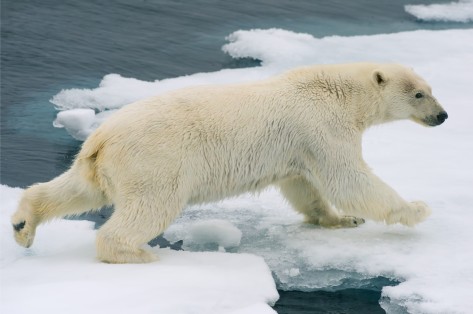More polar bear catastrophe hype

Last week (24 February 2021), The Guardian was promoting a study that claims polar bears now use four times more energy than expected to survive because of ‘major ice loss’ in the Arctic, as a way of suggesting that the animals are already on their way to extinction.
But like many papers of this type, this study by Anthony Pagano and Terri Williams (Pagano and Williams 2021) is yet another model describing what biologists think may be happening based on experimental data collected from individual bears, not a conclusion based on evidence collected from subpopulations with the worst amounts of ice loss.
This is actually a review paper: a summary of what is known about measured energy use by polar bears in lab or zoo contexts (i.e. experimental evidence) – not what happens to bears under a variety of circumstances in the real world on a regular basis. What real-life evidence they use comes from studies on individual bears in the Southern Beaufort (Pagano et al. 2018; Whiteman 2018) in a year that thick spring ice made ringed seal pups scarce (and thus left some bears in less than ideal condition) or from studies of swimming SB bears (Pagano et al. 2012; Pilfold et al. 2016). Such models depend entirely on assumptions which may not be appropriate to apply across the board.
To support their claim, the authors cite a paper published last year by Laidre and colleagues (Laidre et al. 2020) about an apparent decline in body condition and cub survival among Baffin Bay polar bears that seemed to be correlated with declining summer sea ice, despite the fact that the study looked at no other possible factors except ice loss and that the population has been stable.
In addition, Laidre and colleagues included a rather important caveat for their study not mentioned in the Pagano and Williams paper:
“We note, however, that the functional and temporal relationships between declines in body condition and recruitment, and declines in subpopulation size, are poorly understood and that the trend of the BB subpopulation is currently unknown.”
More importantly, however, they ignore strongly contradictory evidence from the Chukchi and Barents Seas, hoping no one will check. However, if their premise was true – that bears in general are using four times as much energy to survive because of sea ice loss – then polar bears in the Barents Sea should be almost gone due to starvation. Barents Sea bears have been dealing with almost four times as much sea ice loss as those in Baffin Bay (Regehr et al. 2016, see graphs below) and according to Pagano and Williams, should not have been in better condition in 2015 than they were before 2005: yet the evidence shows they were (Lippold et al. 2019).
Numerous studies have documented that Chukchi Sea bears are also thriving despite having had only slightly less summer ice loss as those in Baffin Bay (AC SWG 2018; Crockford 2017, 2019; Regehr et al. 2018; Rode et al. 2014, 2015, 2018).
Polar bear specialists fail to mention such contradictions because they hope journalists and policy makers won’t notice: they hype the examples that fit their narrative and ignore or downplay the rest. I’m here to call them out on that kind of subterfuge.
See more here: polarbearscience.com
Please Donate Below To Support Our Ongoing Work To Defend The Scientific Method
PRINCIPIA SCIENTIFIC INTERNATIONAL, legally registered in the UK as a company  incorporated for charitable purposes. Head Office: 27 Old Gloucester Street, London WC1N 3AX.
incorporated for charitable purposes. Head Office: 27 Old Gloucester Street, London WC1N 3AX.
Trackback from your site.


Doug Harrison
| #
Well done, Susan Crockford. You do the human race a great service by calling out these grant hunting frauds.
Reply
Moffin
| #
Q. What do you call a Polar Bear in the Antarctic?
A. Bi Polar.
Reply
Karma Singh
| #
THE clues to polar bear viability are:-
1) A female will usually birth three cubs. Previously, only one will survive to adult. In recent years, however, frequently all three make it to adult.
2) Increased population pressures (because of 1.?) has lead to polar bears moving close to human populations.
Put that in your pipe and smoke it Mr. Pagano.
Blessed be
Karma Singh
Reply
very old white guy
| #
more polar bears means less polar bears, right? kind of like more warming means more freezing.
Reply